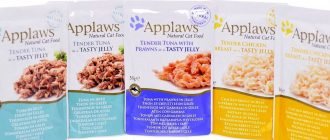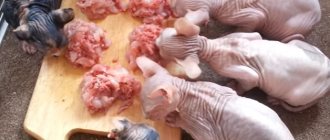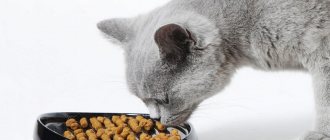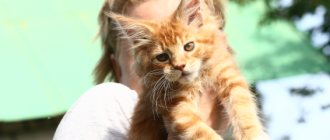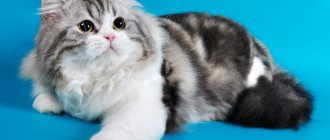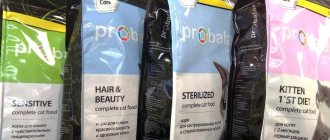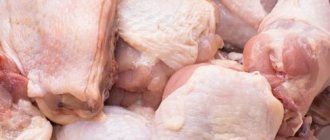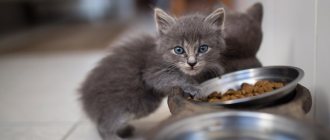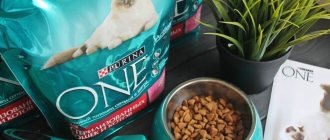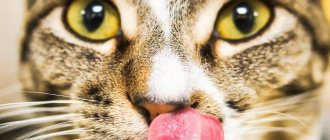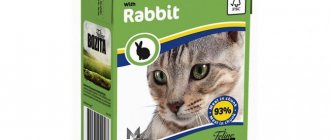February 9, 2020
Every cat owner has certainly thought about what type of feeding is most beneficial for their pet. Most often, the choice is between natural products and dry industrial food. Let us immediately note that you can organize the correct, complete diet with any choice. It is also possible to feed cats natural food and dry food at the same time; let’s try to consider all the nuances of this approach.
Mixed feeding of cats
Cats are small predators whose diet includes birds, small rodents, and insects. Although cats are considered domestic animals, their menu can be considered “wild”.
Types of cat food
There are three types of food for cats, and each of them claims to be complete and balanced. It is impossible to determine for sure which of these species will be most acceptable when feeding a cat. Mixed food for cats should be described in detail.
Benefit
With the “mixed cat nutrition” option, the cats’ food includes both natural products and ready-made industrial food. Feeding alternates types of food, which is how it got the name “mixed”. This method requires a lot of experience when breeding cats. Proper feeding is a diet in which the bulk of food consists of industrial feed. One feeding per day will consist of natural products containing protein . This is not a substitute for natural feeding, so before you start mixing ingredients, do a thorough study of how the animal will react.
Nutritional balance
The food produced by the industry contains the entire complex of vitamins and microelements necessary for the full development of a pet. And such nutrition will be justified only if the dry and liquid foods are of high quality and have received veterinary approval. Mixed food should be used with caution so as not to make this type of diet harmful to the cat’s body.
The cat's well-being
It is important for breeders to choose the right cat nutrition. And in this case, many prefer natural feeding. You need to choose the type of feeding from the moment you bring the kitten into the house. The most important thing in nutrition is freshly prepared food. If a cat eats its portion with pleasure, is cheerful and playful, it means that the animal receives, along with food, all the elements necessary for growth and health.
Standardization in nutrition
It is very difficult to maintain the calorie content of feed; you must strictly follow the required daily intake of vitamins and all nutrients obtained from food. Natural products that any cat or cat on a mixed diet receives can be as follows :
- beef or poultry meat,
- fish,
- dairy products,
- offal,
- cream.
Mixed nutrition requirement
One of the requirements for breeders with a mixed diet: clean water and dry food. Once a day you can offer your pet a fish or meat dish. Be careful not to have too much meat. After all, industrial food already contains a balance of all the microelements, minerals and vitamins that a cat needs. Sometimes the type of food is dictated by the breed, so a large British cat needs more meat food than a cat of another graceful breed. But, despite all this, the usual daily intake of meat should reach no more than 20% of the total amount of food .
Vitamin and mineral supplements
With a mixed diet, a break of 3 hours must be observed between the consumption of industrial feed and natural food. It is recommended to give natural products in the evening, and place food from a pack or bag in a bowl nearby throughout the night. Vitamins and minerals should be added only by half so as not to increase their dose, since they are already added to industrial feeds. It is necessary to remember one general rule that must be followed for any type of animal nutrition. No smoked meats, sausages or cutlets that are prepared for lunch or dinner for people should be included in cat food.
Source
And finally...
Perfect Fit™ diets were developed based on the experience of the WALTHAM Veterinary Research Center. Our food is created taking into account the lifestyle of cats in the modern world and takes into account all their needs. We know that a cat's well-being is more than just good nutrition. A healthy diet is a must, but physical activity and play are just as important to your pet's well-being, helping to provide a better standard of living where your cat can enjoy every day from a young age through to old age.
- 1 Ipsos Pet Grooming Survey 2016.
- 2 For an adult cat with an average weight of 4 kg. WALTHAM® Science.
- 3 Cameron 2010, Alexander 2013, WALTHAM® Science.
Proper mixed food for cats
Both veterinarians and the owners of these animals are still arguing about whether it is possible to feed a cat a mixed diet. This diet includes not only natural food, but also ready-made commercial feed. The main thing you should pay attention to when it comes to mixed cat nutrition is balance. The animal should receive equal amounts of proteins, fats and carbohydrates, as well as additional vitamins and beneficial microelements.
With this approach, of course, it is better to consult a veterinarian, and if the cat is purebred, get comprehensive information from an official breeder. The specifics of the functioning of the digestive system in different breeds also differ from each other, despite the fact that the cat is by nature a predator, and eating meat or fish is something that is inherent in nature. But overfeeding with meat does not always have a positive effect on the functioning of the stomach. The standard daily intake of meat ingredients should not exceed 20% of the total amount of food consumed.
Veterinarians' opinion
Most veterinarians are not fans of mixed diets. This is due to a very simple thing: natural food itself contains enough moisture, so the cat does not need to drink a lot of water. Whereas dry food takes away this moisture.
Such a difference can negatively affect the functioning of the kidneys. If, nevertheless, the desire to pamper your pet with something tasty is so great that it is difficult to resist, you should give preference to canned food of the same brand as dry food. Thus, the cat’s body is guaranteed to receive exactly the composition of nutrients and microelements that your animal needs.
Veterinarian checking cat's health
Mixed diet
Without special education and a home laboratory, it is difficult to calculate the amount of essential microelements that an animal should receive daily. You can, of course, use various online calculators, but this does not guarantee a 100% correct result.
Therefore, before switching your pet to a mixed diet, develop its future diet taking into account the recommendations of professionals. Among the natural products that a cat can receive on such a diet are:
- Poultry or beef.
- Fish.
- Dairy products.
The rest of the diet consists of feed. As a rule, they are also additionally enriched with vitamins and essential microelements, the use of which is a good prevention of various diseases.
One meal should consist of natural meat or fish or fermented milk products, the rest from feed. Thus, the necessary microelements and nutrients will gradually enter the animal’s body.
Approximate food distribution schedule for natural-fed cats
| Product | Mon | VT | SR | Thu | PT | SB | VSK | |||||||
| morning | evening | morning | evening | morning | evening | morning | evening | morning | evening | morning | evening | morning | evening | |
| MAIN PRODUCTS | ||||||||||||||
| Dairy products | + | + | + | + | + | + | + | |||||||
| beef | + | + | + | + | + | |||||||||
| beef heart | + | |||||||||||||
| fish | + | |||||||||||||
| MEAT ADDITIVES | ||||||||||||||
| olive oil | + | + | + | + | + | + | + | |||||||
| SA 37 or other vitamins according to instructions | + | + | + | + | + | + | + | |||||||
| Dry seaweed, on the tip of a knife | + | + | + | + | + | + | + | |||||||
| Vegetables | + | + | + | |||||||||||
The benefits of mixed food for cats
If we talk about the benefits of mixed nutrition, then, guided by the opinion of the majority, it is food that should be mixed: wet and dry, and not natural products with dry food. A variety of flavor combinations will allow your pet to try new tastes and always remain in a great mood.
The choice in favor of such a mixed diet is also due to the fact that the food already contains a balanced amount of substances necessary for the normal functioning of the body and overall well-being. And there is no need to add anything else. The main thing is to constantly monitor the availability of fresh drinking water: after all, when feeding dry food, drinking plenty of fluids is a prerequisite.
"The Appetite of a Neutered Cat"
In modern conditions, at the age of one year, 93% of all cats have already undergone sterilization1, while 10% of all cats never go outside. This creates conditions for a sedentary lifestyle and, accordingly, increases the risk of gaining excess weight and developing diseases of the urinary system. In addition, most adult cats experience a gradual decline in their overall activity level. This is why it is very important that after sterilization, the daily amount of food is recalculated and changed based on recommendations for maintaining your pet's ideal weight. The attending veterinarian will tell you how to properly approach the issue of nutrition after sterilization.
Advice from Dr. Corinne Lauzen, Consulting Veterinarian for Perfect Fit - “After spaying, a cat may be prone to weight gain. Pet owners should not make the common mistake of increasing portion sizes due to weight gain, thinking that their cat is still growing.
One of the effective methods for controlling a cat's body weight is mixed feeding - a combination of dry food and, for example, 1 bag of wet food per day. Wet diets contain more water, meaning a larger portion of wet food contains the same number of calories as a regular portion of dry food, keeping your cat full and in good shape.
In addition, the combination of wet and dry food has other positive qualities: it helps maintain water balance and takes care of the health of the genitourinary system. It also makes the diet more varied and interesting, which your cat will certainly appreciate.
Vitamin supplements
Ready-made food is good because it already contains nutrients and vitamins in the required quantities and proportions. This is especially true for super premium and holistic foods. In this regard, there is no need to additionally introduce a multivitamin complex into the diet, except for health problems. And you shouldn’t do this without consulting a veterinarian.
Cat chooses food
It is worth taking vitamin supplements if the daily diet includes natural products , and the amount of prepared food consumed does not ensure the daily intake of nutrients into the body. As a rule, these are vitamins A, E, and group B. A lot of literature has been written about the benefits of each of them, so it makes no sense to focus on this information. In addition, these are not all vitamins that can be consumed to maintain the normal functioning of body systems.
Source
Diet of older cats
If your cat begins to consume less water than usual, this can cause problems with the health of the genitourinary system. In this situation, mixed feeding is more useful than ever: 2 bags of wet food per day2 provides 73% of the daily water requirement! By the way, British Shorthair, Persian and Siamese cats are more at risk of developing calculi (stones) in the bladder. Urinary stones are formed from minerals found in urine and can lead to painful and difficult urination.
Fact: According to the WALTHAM Research Center3, cats whose diet included more water were more physically active than those whose diet contained less moisture. Think about it!
Feeding mode
By 4-5 weeks, the kitten needs to develop a regular food intake routine. Feeding should be from 4 to 7 times a day, but these recommendations are average and can be adjusted up or down.
Recommended feeding frequency per day, depending on age:
- from 4 to 8 weeks – up to 7 times, night feeding should be avoided;
- from 8 to 12 weeks – up to 6 times;
- from 16 to 20 weeks – 5 times;
- from 5 to 9 months – 4 times;
- from 9 months to 1 year – three times a day.
A kitten over the age of 1 year should get used to eating twice a day with a mandatory 12-hour break.
Portions must meet the following sizes:
- from 4 to 6 weeks : 120 g of food per day;
- 8 weeks : from 160 to 180 g;
- from 12 weeks to 6 months : from 180 to 240 g, of which at least 40 g should be allocated to meat;
- 6-9 months : 180 g of food per day;
- from 10 months to 1 year : from 150 to 200 g.
You should at least approximately adhere to the amounts of food recommended by the veterinarian and the breeder. Overeating can cause major health problems in the future. An adult cat may develop obesity, pancreatitis, and diabetes.
Diet of a one-week-old kitten
If the mother cat does not have enough milk or the kitten grows up without her, the owners should know what is allowed to feed such babies. During this period, the most important thing is not to spoil their stomach and provide the body with all the necessary useful components. Therefore, the menu of a seven-day kitten includes the following:
- 500 ml of high concentration milk and chicken yolk, raw;
- 2.5 g of dry yeast and 15 g of milk (only dry and whole), 50 g of whole cow's milk;
- beaten chicken protein and 1 hard-boiled egg, 4 g of sugar (grape) and 1 g of vegetable oil. oils;
- corn oil - half a teaspoon, 50 ml milk and 1/2 yolk.
When the baby reaches four weeks of age, you can gradually begin to feed him.
Authorized Products
Small animals allowed on the menu:
- Meat – served raw, boiled or scalded with boiling water. Only low-fat varieties are suitable. Meat products should make up from 60 to 80% of the total daily food intake.
- Liver – no more than 2 times a week.
- Porridges – any are suitable, except semolina. All kittens are not fans of cereals, but they contain many substances that the growing body needs. It is recommended to mix meat and porridge in a ratio of 2 to 1.
- Vegetables - any, except potatoes, served boiled or raw.
- Chicken eggs - small pets can only be given the yolk. Its consumption is also allowed in raw form, but not more than once every 7 days. The yolk of quail eggs can be consumed simultaneously with the white.
- Fermented milk products - any, but with a minimum percentage of fat content. The exception is sour cream; giving it to kittens is strictly prohibited.
- Oil – not vegetable oil, but Vaseline is recommended.
- Brewer's yeast - affects the coat of a small pet.
What is prohibited for a kitten
In order not to provoke complications in the functioning of the baby’s gastrointestinal tract, the following products should not be on the menu:
- freshwater fish;
- salt;
- Cow's milk is too harmful; goat's milk is best. In its absence, cow milk is allowed, but in dry form. Cow's milk can only be given to a kitten up to 12 weeks;
- purchased sausages;
- potatoes - the starch present in the vegetable is not digested or absorbed;
- any legume products - cause fermentation and flatulence;
- cheese is a very fatty product that negatively affects the pancreas;
- pork, lamb is also not recommended;
- any sweets (homemade and store-bought);
- flour and bakery products.
It is not allowed to introduce ready-made industrial food into the kittens’ menu that is not appropriate for their age.
Diet recommendations according to the age of the kitten
A 2-4 month old kitten has already developed sharp teeth; he should be able to eat from a bowl himself. Intensive growth and development of the animal requires a balanced and varied diet. The basis of the diet is lean meat, vegetables (preferably boiled) and porridge. The cereal should be boiled in a large amount of water so that the resulting porridge has a liquid consistency. Half of the diet consists of low-fat sour milk.
From 4 to 6 months, the animal’s body actively builds and strengthens muscle mass. The basis of the diet is beef and chicken, cut into small cubes and offal. Fermented milk products are allowed, but in smaller quantities. Cow's milk should be removed from the diet. Porridges are cooked with less water to make the consistency thicker. It is recommended to introduce boiled and raw vegetables, cucumbers, and zucchini into the kitten’s diet.
The animal's nutrition expands from 6 months. All products should be cut into large cubes, and porridge should be cooked more crumbly. It is during this period that it is recommended to include industrial feed in the diet, according to the age category of the animal.
Approximate diet for a week with the permissible frequency of consumption of certain foods
| Product | Quantity per week |
| Beef | Daily |
| Boiled chicken | Up to 4 times. |
| By-products (chicken and cow) | Up to 3 times, and the liver - no more than once. |
| Fish - exclusively boiled, without bones, preference is given to sea fish | Cat - up to 2 times, cat - no more than 1 time. |
| Chicken egg yolk | Up to 2 times. |
| Porridge on water - oatmeal, rice | Daily. |
| Fermented milk products | Daily. |
| Low fat cottage cheese | Up to 4 times. |
| Vegetables (cooked or raw) | Up to 3 times. |
| Greens – spinach, wheat germ | Up to 2 times, as an additive to meat. |
| Brewer's yeast | Up to 4 times. |
The kitten's bowl should always contain clean drinking water (boiled or filtered, purified). It should be changed daily.
Do kittens need commercial food?
There is no clear opinion among veterinarians regarding the need to give a kitten industrial food - dry or wet canned food. Many agree that this type of feeding is only suitable for owners who do not have time to prepare separate meals for kittens.
Other veterinarians and breeders believe that only by introducing industrial diets into the menu can one give the pet’s body enough vitamins and minerals. As practice shows, giving kittens industrial food is not only possible, but also necessary. The main thing is to know how to choose and enter them correctly.
Which is better: natural or prepared food?
It is difficult to answer the question unambiguously. Premium class industrial mixtures contain all the nutrients an animal needs. The mixtures do not require a long time to prepare, always remain fresh, free the owner from constant care, but are expensive.
Eating natural foods has many benefits. The owner is confident in the contents of the bowl, knows exactly what ingredients were prepared, and can adjust the diet depending on the cat’s taste preferences.
Disadvantages - food spoils quickly, a lot of time is spent on preparation, the cost of quality products is high.
How to transfer a kitten to industrial food
Most owners prefer ready-made food. This diet is convenient for owners who are away from home for a long time. In addition, it is possible to give the animal food for future use if it needs to go away for several days.
Industrial food is also useful for kittens, since it contains useful minerals that are almost impossible to obtain in the proper quantities from natural food.
The optimal age for introducing a pet to commercially produced food is 5 months, when the kitten is already fully eating the foods it is allowed to eat. It is recommended to accustom you to industrial feed according to the following scheme:
- 1 day – 75% of the food that the kitten is accustomed to, and 25% of purchased food;
- 2 days – usual, natural food and feed should be in equal volumes;
- Day 3 – 75% new food and 25% natural food;
- 4 days - the kitten is completely transferred to industrial food.
If the kitten refuses to eat dry food on the first day and does not even touch it, the process of transferring it to this type of feeding should be postponed for several days.
Is it possible to feed a cat dry food and natural food at the same time: pros and cons, which is better?
For many years, heated debates between supporters and opponents of dry food and natural nutrition have not subsided. The former are confident that dry food is beneficial for the body of furry animals, the latter consider natural food products to be an ideal option.
But most often, pet owners are interested in the question: is it possible to feed a cat dry food and homemade food at the same time?
According to veterinarians, feeding your pet different types of food can create problems and lead to the development of a number of chronic diseases.
It's all about the physiology of the animal, the cat's stomach is capable of producing one type of enzyme, therefore, combining different types of food can ruin the animal's digestion.
Diet rules with industrial feeds
If the owner decides that his pet will only consume ready-made diets, whether dry or canned, from this moment on it is recommended to adhere to certain rules:
- Natural food and industrial nutrition are combined only during the period of accustoming the kitten to store-bought canned food or dry food. In the future, the pet should only be on one type of feeding. Constantly combining natural and industrial food can lead to an imbalance of vitamins and nutrients, which will not have the best effect on the condition and functioning of the digestive system and the entire body.
- A kitten accustomed to commercial diets should always have fresh, clean water in its bowl. For an animal that eats only dry food, water is the only source of liquid. The owner must ensure that his pet regularly drinks water. If the kitten does not drink it often, you should train it. Lack of fluid when eating dry food can further provoke the development of urolithiasis.
- It is recommended to give preference in industrial food to wet canned food, as they are more nutritious, tastier and contain moisture.
- To make the canned food even tastier and more aromatic, especially if the animal has difficulty getting accustomed to ready-made food, it is recommended to heat the jar to 40°.
- It is not recommended to give dry and wet food at the same time, mixing them in the same bowl. The optimal option for feeding a kitten: the base is dry food, and canned food is periodically included in the menu.
- You only need to purchase a ready-made diet with a note indicating the appropriate age. Giving small animals the same industrial food that is intended for adults is prohibited.
Classification and features of industrial feeds
On mobile, you can scroll the table horizontally with your finger.
| Name | Advantages | Flaws |
| Economy class Darling, etc. | low cost |
|
| Premium class Doctor Alders, etc. |
|
|
| Super-premium class Bosh, etc. |
| the cost is quite high |
| Holistics Eagle Pack Holistic Select Felidae, etc. |
| the cost is high, not affordable for everyone |
Economy or medium food refers to a type of industrial food that is secretly called fast food for representatives of the cat world. This is the cheapest, most budget option, which has many disadvantages. Such food is made from the cheapest, low-quality products.
There is practically no meat in the composition. The meat part is represented mainly by waste. To enhance the taste of these products, chemical preservatives, flavor enhancers, flavorings, as well as catnip, which is an analogue of valerian, are added to the composition. Giving such food on a regular basis is highly discouraged, as this can lead to serious problems with the digestive system and health of the animal.
Super-premium class - they cost more than economy class, but they do not always meet the requirements. The advantage of such foods is that they do not contain food colors or flavors. They contain more meat than in economy category feeds, and the taste is a level higher. These types of feeds are quite well accepted by the animal’s digestive system.
Holistics are the most expensive class of cat food, but their quality is appropriate. The composition contains a large amount of natural, good meat. No dyes or flavor enhancers. The composition of the food fully corresponds to natural nutrition.
Recommended canned foods
On mobile, you can scroll the table horizontally with your finger.
| Name of food | Advantages | Flaws |
| Bosh Sababelle Super premium class |
| The food contains large quantities of maize and cellulose - components that can provoke a food allergy in a kitten. |
| Pro Plan Junior Premium class |
| The composition contains a high concentration of protein of plant origin. The food contains corn and soy - products that provoke allergic reactions. Preservatives are also present in the composition. |
| Hills Premium class |
| A high concentration of carbohydrates, which are poorly absorbed by the kitten’s digestive system, there are components that can cause allergies, canned food contains a lot of water and broth. |
